Minimally Invasive (non-surgical) Treatments Provided by Interventional Radiologists
As vascular & non-vascular experts, interventional radiologists help Patients avoid needless suffering
by providing minimally invasive treatment options. For many years, surgery was the only treatment available for
many conditions. Today, interventional radiology treatments are first-line treatment.
Interventional radiologists treat by non-surgical treatment options for many diagnosed/ misdiagnosed
conditions such as: -
- Uterine Fibroids
- Uterine Adenomyosis
- Blocked Fallopian Tubes
- Chronic pelvic pain (Pelvic congestion syndrome)
- Varicose Vein in legs
- PAD / Leg Pain / Lower limb vascular disease.
- Un-operable Liver tumor
- Leg Pain from Peripheral Artery Disease
- Enlarged Prostate
- Varicocele
- Hemangiomas
- Hemoptysis (Coughing of blood)
- Osteoporosis (now treated by Vertebroplasty)
- O3 therapy for slipped disc.
1) Chronic Pelvic Pain (Pelvic Congestion Syndrome)
It is estimated that one-third of all women will experience chronic pelvic pain in their lifetime.
Many of these women are told the problem "is all in their head," but recent advancements now
show the pain may sometimes be due to hard-to-detect varicose veins in the pelvic area, known as pelvic
congestion syndrome. The minimally invasive outpatient / day care procedure seals the faulty vein using
embolization.
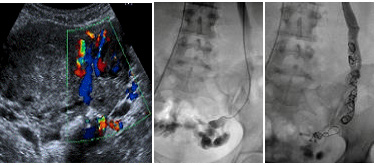
Picture 1: - USG Doppler study of pelvis shows prominent ovarian veins.
Picture 2: - Ovarian vein venography shows dilated veins in pelvis cause of chronic pelvic pain.
Picture 3: - Shows blocking of dilated ovarian vein by multiple coiles.
2) Uterine Fibroids
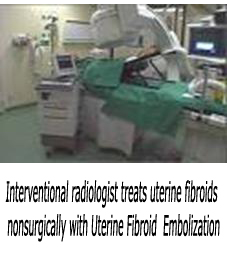 Uterine fibroids are very common non-cancerous (benign) growths that develop in the muscular wall of the uterus.
Although hysterectomy, performed by a gynecologist, is the most common treatment for symptomatic uterine fibroids,
most women actually don't need hysterectomy. Non Sugical treatment uterine fibroid embolization (UFE) is now the best
treatment option performed by Interventional radiologists. UFE, also known as uterine artery embolization, blocks the
blood flow to the fibroid tumor, causing its degenration and causing symptoms to subside
Uterine fibroids are very common non-cancerous (benign) growths that develop in the muscular wall of the uterus.
Although hysterectomy, performed by a gynecologist, is the most common treatment for symptomatic uterine fibroids,
most women actually don't need hysterectomy. Non Sugical treatment uterine fibroid embolization (UFE) is now the best
treatment option performed by Interventional radiologists. UFE, also known as uterine artery embolization, blocks the
blood flow to the fibroid tumor, causing its degenration and causing symptoms to subside
Interventional radiologist treats uterine fibroids nonsurgically with Uterine Fibroid Embolization
3) Uterine Adenomyosis
Adenomyosis is a disease which involves the uterus and it has long been an underdiagnosed condition of the uterus. Severe pain and excessive bleading are the common symptoms. About 30% of uterine fibroids are associated with Adenomyosis (bulky / enlargement of uterus). Adenomyosis is the presence of uterine lining tissue (endometrium) deep within the myometrium (muscular wall) of the uterus causing enlargement of the uterus.

The ultrasound imaging often fails to distinguish the two conditions. Diagnosis of these conditions is done by ultrasonography and modern imaging techniques like MRI.
In India most of the patients still depend on their family doctors & consulting gynecologist for their complete medical information. And many women unfortunately have to undergo hysterectomy (surgical removal of uterus) thinking that no other treatment is available for their uterine problem even if they are young without knowing the complications of these major surgeries. While in USA & Europe, people now go through internet for getting best information & hence can chose the best possible treatment options.
Till now the only treatment available for adenomyosis was medication, which if did not help, then patients were forced to undergo surgical removal of uterus (hysterectomy) but these are the major surgeries with high rate of complications like recurrence, sudden menopause, obesity, emotional trauma and loss of libido.
But now a very effective, easier then abortion & patient-friendly non-surgical technique called “Uterine Artery Embolization” is available that requires only 12-24 hrs hospitalization, no risk of anesthesia, no surgical scar on abdomen, short recovery than from hysterectomy or even laparoscopic surgery, all fibroids & adenomyosis are treated at one sitting, no blood loss or risk of blood transfusion, resolution of heavy bleeding in majority, within 24 hours. Not only this, even uterus will remains in the same position. Emotionally, financially and physically , embolization has an overall advantage over laparoscopic/ Abdominal surgery. Uterine artery embolization treatment is easier then simple abortion technique and worth trying if women want to save the uterus and to avoid major surgery like hysterectomy.
4) Opening of blocked Fallopian Tubes
Infertility affects lakhs of couples in India. In females, blockade of fallopian tubes are the most common
causes of infertility and is seen in 30-40% of these couples.
Due to lack of awareness about non-surgical treatment, patients frequently undergo surgical treatment, which
results in surgical scar, long hospitalization, chances of infections, and done under general anesthesia.
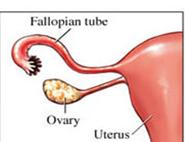 The diagnosis of blocked fallopian tube procedure is done 6 to 10 days after the first day of the patient
’s last menstrual period. In the same sitting the interventional radiologist performs the treatment
of opening of blocked fallopian tube. He inserts a thin tube inside the uterus and very thin platinum wire
passed through the fallopian tube on both sides under vision of high-end digital monitor. Patient can watch
the entire procedure on computer monitor. The procedure usually takes 30 to 45 minutes and patient
can go home after one hr.
The diagnosis of blocked fallopian tube procedure is done 6 to 10 days after the first day of the patient
’s last menstrual period. In the same sitting the interventional radiologist performs the treatment
of opening of blocked fallopian tube. He inserts a thin tube inside the uterus and very thin platinum wire
passed through the fallopian tube on both sides under vision of high-end digital monitor. Patient can watch
the entire procedure on computer monitor. The procedure usually takes 30 to 45 minutes and patient
can go home after one hr.
5) Osteoporosis
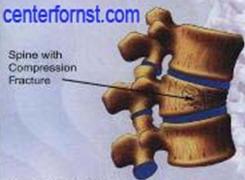
Vertebroplasty is a pain treatment for vertebral compression fractures that fail to respond to conventional pain
therapy. Vertebroplasty, a nonsurgical treatment performed by interventional radiologist using imaging for guidance,
stabilizes the collapsed vertebra with the injection of medical-grade bone cement into the spine
6) Varicose Veins
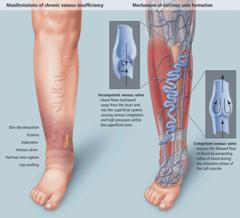 Varicose Veins is an abnormal circulatory condition in which the valves in the vein that pump the blood back up to
the heart become weak and don’t close properly, thus allowing blood to flow backwards down the leg
(called reflux). Varicose veins are prominent veins that have lost their valve effectiveness and, as a result of
dilation under pressure, become elongated, rope-like, bulged and thickened. Interventional radiologists treat
varicose veins non-surgically using vein ablation (Radiofrequency Ablation) , they seal the faulty vein
closed using heat treatment.
Varicose Veins is an abnormal circulatory condition in which the valves in the vein that pump the blood back up to
the heart become weak and don’t close properly, thus allowing blood to flow backwards down the leg
(called reflux). Varicose veins are prominent veins that have lost their valve effectiveness and, as a result of
dilation under pressure, become elongated, rope-like, bulged and thickened. Interventional radiologists treat
varicose veins non-surgically using vein ablation (Radiofrequency Ablation) , they seal the faulty vein
closed using heat treatment.
7) Leg Pain from Peripheral Artery Disease
Peripheral artery disease is a common circulatory problem in which narrowed arteries reduce blood flow to the limbs. The legs don’t receive enough blood flow to keep up with the demand of day to day walking. This causes symptoms, most notably leg pain when walking called claudication which disappears after a few minutes of rest but again pain starts when a person starts walking. Smoking, Diabetes, obesity, high blood pressure, high cholesterol are the commonest risk factors for this disease. They cause build up of fatty deposits in the arterial wall there by narrowing the lumen and reducing blood flow.
8) Ozone-Oxygen Therapy for slipped disc.
Oxygen-ozone therapy is one of the most effective minimally invasive treatments currently available. Actions of ozone are: -
- Reduction in herniated disk volume, as disk shrinkage may reduce nerve root Compression.
- Disk shrinkage may also help to reduce venous stasis caused by disk compression of vessels, thereby improving local microcirculation and increasing the supply of oxygen. This effect has a positive effect on pain as the nerve roots are sensitive to hypoxia.
- Immunomodulating action
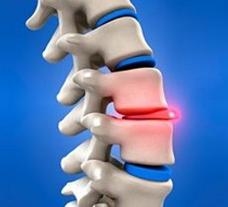 Analgesic and antiinflammatory effects
Analgesic and antiinflammatory effects- Administering medical ozone followed by injection of a corticosteroid and an anesthetic at the same session gives better result.
Indications:
- Clinical signs of lumbar disk nerve root compression,
- CT and/or MR evidence of contained disk herniation.
- Chronic joint pain and swelling.
Success rate: 70.- 80%
9) Percutaneous vertebroplasty for painful fractured vertebral body.
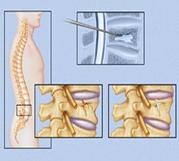 Percutaneous vertebroplasty is a newer non-surgical technique in which a medical grade
cement is injected though a needle into a painful fractured vertebral body. This stabilizes the fracture,
allowing most patients to discontinue or significantly decrease analgesics and resume normal activity
Percutaneous vertebroplasty is a newer non-surgical technique in which a medical grade
cement is injected though a needle into a painful fractured vertebral body. This stabilizes the fracture,
allowing most patients to discontinue or significantly decrease analgesics and resume normal activity
10) Enlarged Prostate
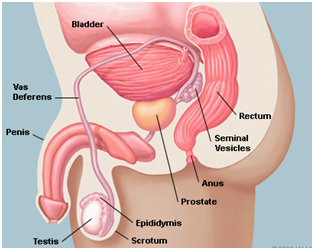 As a man ages, there is a good chance that he will develop an enlarged prostate or benign prostatic hyperplasia
(BPH). In fact, it is estimated that close to 80% of men will develop BPH. More than 40% of men who develop an
enlarged prostate will need treatment to correct symptoms from this enlarged prostate. Till now the surgical
treatment TURP has been the commonest treatment available which had severe complications like heavy bleeding
after surgery, infection, erectile dysfunction etc. But now a very effective non surgical treatment is available
called Prostatic Artery Embolization which is free of any complications and requires just one day hospitalization
with no general anesthesia.
As a man ages, there is a good chance that he will develop an enlarged prostate or benign prostatic hyperplasia
(BPH). In fact, it is estimated that close to 80% of men will develop BPH. More than 40% of men who develop an
enlarged prostate will need treatment to correct symptoms from this enlarged prostate. Till now the surgical
treatment TURP has been the commonest treatment available which had severe complications like heavy bleeding
after surgery, infection, erectile dysfunction etc. But now a very effective non surgical treatment is available
called Prostatic Artery Embolization which is free of any complications and requires just one day hospitalization
with no general anesthesia.
11) Varicocele
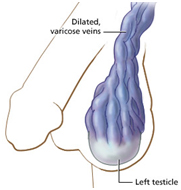 Varicocele is a relatively common condition (affecting approximately 10 percent of men) that tends to occur in
young men, usually during the second or third decade of life. Sometimes, these varicoceles cause no symptoms
and are harmless. But sometimes a varicocele causes pain or atrophy (shrinkage) of testis, or fertility problems.
There is a network of tiny veins in the scrotum that drain into a long vein in the abdomen. Sometimes the one way
valves in these veins fails causing stretching and enlargement of these veins called varicocele.
Varicocele is a relatively common condition (affecting approximately 10 percent of men) that tends to occur in
young men, usually during the second or third decade of life. Sometimes, these varicoceles cause no symptoms
and are harmless. But sometimes a varicocele causes pain or atrophy (shrinkage) of testis, or fertility problems.
There is a network of tiny veins in the scrotum that drain into a long vein in the abdomen. Sometimes the one way
valves in these veins fails causing stretching and enlargement of these veins called varicocele.
12) TACE and RFA for Liver Tumor
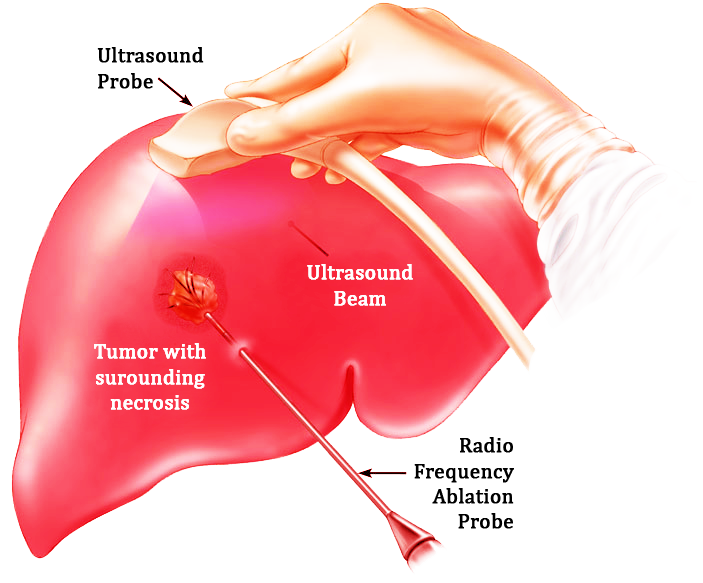 Most patients with HCC are diagnosed at intermediate to advanced stage, and there is no standard treatment for these
patients. Definitive surgical intervention is not feasible in most cases due to extreme tumor extension, multiplicity of
tumor foci & associated liver cirrhosis at the time of diagnosis. Several Non Surgical options are now available for the
treatment of malignant liver tumours (hepatocellular carcinoma (HCC) and metastasis), which helps to improve the quality
of life in otherwise inoperable liver tumours.
Most patients with HCC are diagnosed at intermediate to advanced stage, and there is no standard treatment for these
patients. Definitive surgical intervention is not feasible in most cases due to extreme tumor extension, multiplicity of
tumor foci & associated liver cirrhosis at the time of diagnosis. Several Non Surgical options are now available for the
treatment of malignant liver tumours (hepatocellular carcinoma (HCC) and metastasis), which helps to improve the quality
of life in otherwise inoperable liver tumours.
Following are the various non surgical treatment available
1) Chemoembolization
2) Radiofrequency Ablation (RFA)
3) Yttrium-90 Radioembolization
4) Cryoablation
5) Microwave Ablation
13) Hemangiomas
 Hemangiomas and vascular malformations are noncancerous growth of blood vessels. They show up at birth or soon
after birth. Hemangiomas shrink and disappear on their own while vascular malformations keep growing slowly
throughout life and they usually require treatment. These lesions sometime infiltrate normal tissue which makes
them very difficult to manage.
Hemangiomas and vascular malformations are noncancerous growth of blood vessels. They show up at birth or soon
after birth. Hemangiomas shrink and disappear on their own while vascular malformations keep growing slowly
throughout life and they usually require treatment. These lesions sometime infiltrate normal tissue which makes
them very difficult to manage.
Surgery is not a treatment option for these vascular growths because of high risk of bleeding. Also infiltration
of the surrounding tissue makes them difficult to remove completely, hence regrowth after surgery is common.
Non surgical treatment called embolization is the treatment of choice and very easy and comfortable for the patient.
14) Hemoptysis (Coughing of blood)
 Development of moderate and massive hemoptysis (generally more than about 1 cup, in 24 hours) is risky and the
mortality rate for patients with massive hemoptysis can be as high as 75%. Most patients die from lack of oxygen
due to too much blood in the airways. Tuberculosis is the most common cause of hemoptysis. Other causes are
bronchitis, bronchiectasis, vascular disorders, pulmonary AVM, trauma.
Development of moderate and massive hemoptysis (generally more than about 1 cup, in 24 hours) is risky and the
mortality rate for patients with massive hemoptysis can be as high as 75%. Most patients die from lack of oxygen
due to too much blood in the airways. Tuberculosis is the most common cause of hemoptysis. Other causes are
bronchitis, bronchiectasis, vascular disorders, pulmonary AVM, trauma.
An effective non-surgical treatment for stopping life-threatening massive and moderate hemoptysis is called
“Bronchial Artery Embolization” and is an Interventional Radiological procedure
Dr.Pradeep Muley M.D. Head and Senior Consultant Interventional Radiologist at Fortis hospital, New Delhi trained from John’s Hopkins Medical Institutions USA and Singapore general hospital says these non-surgical treatments for various diseases are now becoming popular in India like in western countries. As more and more people become aware of these treatments, they will replace the surgical treatment to a large extent.